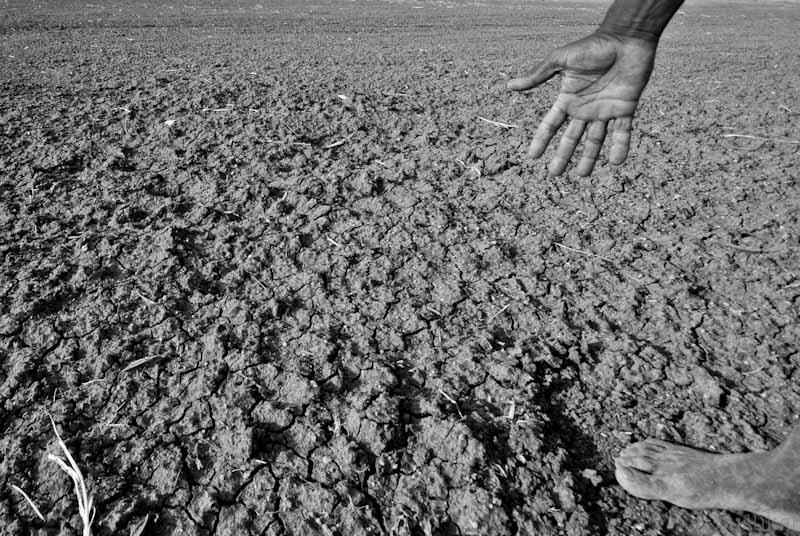
Drought-stricken farmland in Karnataka [Image Credits: Pushkarv / CC BY-SA 3.0)
With climate change occurring at an alarming speed, study finds that temperatures across many parts of the globe, including South Asia, could reach the breaking point by 2050.
No matter what temperature it is outside, our body maintains a constant internal temperature of 36.8°C through a process called thermoregulation centred in the brain. It involves balancing the ambient temperature and the heat that the body produced due to metabolism. The body uses multiple mechanisms, including sweat glands, skin, and walking on two legs to regulate the temperature. However, this amazing mechanism can work until a limit after which our body gives up. Extreme heatwaves, with soaring temperatures, are a huge threat, resulting in deaths and severe economic impacts. Now, a recent study has highlighted the challenge posed by increasing heat and humidity for the survival of humanity.
The study, by researchers from the USA and UK, has analysed weather station data around the world and has found that heat and humidity have increased rapidly. This increase has been prominent in the last four decades in parts of the subtropics, where the temperatures are close to 35°C, threatening our survivability. It also predicts that such intolerable temperatures will be more frequent in parts of South Asia and the Middle East as early as 2050. The findings of the study were published in the journal Science Advances.
Conventionally, temperature readings are expressed as dry-bulb and wet-bulb temperatures. What we measure with a thermometer hanging on the wall, which gives the temperature of the air around it, is the dry-bulb temperature. Wet-bulb temperature is recorded from a thermometer covered by a wet cloth, which also gives a sense of the humidity in that place. When wet-bulb temperatures cross the 35°C mark, the difference between the ambient temperature and that of our skin (which is also 35°C) decreases. As a result, the cooling mechanisms become ineffective, increasing the internal body temperature to around 42–43°C, which is lethal for humans.
The current study evaluated temperature data from 1979 to 2017 and found two instances of wet-bulb temperatures exceeding 35°C for about two hours in parts of South Asia, the coastal areas of the Middle East and southwest North America. Along the Persian Gulf coastline, it was found that the wet-bulb temperature value had exceeded 31°C for 14 times in 39 years. Other instances where the wet-bulb temperature peaked at 31°C were observed in parts of India, Pakistan, the shores of the Red Sea, among other areas that are situated in the sub-tropics.
A common factor that was noticed in all these regions was that they are typically semi-enclosed gulf or bay areas, with shallow waters, hindering ocean circulation that increases seawater temperature. All these factors combined with the heat of the land is bound to raise the wet-bulb temperature. The study also observed that these wet-bulb temperature extremes are more frequent and largely seen around the onset of monsoon in South Asia, especially in the northern and western regions. This observation suggests the critical role of moisture in containing extreme wet-bulb temperature.

A map depicting the rise in temperatures. The colour symbolizes the daily max wet-bulb temperature between 1979-2017 and the number of markers represent the number of times they have occurred in this period.
[Image Credits: https://advances.sciencemag.org/content/advances/6/19/eaaw1838/F1.large.jpg]
Upon discovering that the wet-bulb temperature exceeded only in certain areas, the researchers projected future occurrences of wet-bulb temperature extremes using climate models. They calculated the temperature of emergence—the amount of global warming required to breach the 35°C wet-bulb temperature threshold. It was found that a temperature rise of 1.3°C over the waters of the Persian Gulf in the mediterranean sea will increase the frequency of the wet-bulb temperature crossing the 35°C point. The researchers estimate that with an increase in global temperature of less than 2.5°C, the wet-bulb temperature will regularly exceed 35°C in the near future.
The coastlines are more at risk than inland areas because of the movement of hot ocean air onto the land. The Southern Persian Gulf and Northern South Asia are the regions in the front line of exposure as these areas house millions of people, who are all at risk of the increased wet-bulb temperature, affecting their physiology. The researchers state that the increasing extreme humid heat will pose “major societal changes in the coming decades.”
The increased humid heat (heat with high moisture in the air) has severe implications for human health and hence, collecting health data in collaboration with public health experts and social scientists are necessary. Such focused studies might help answer questions on how the elderly, outdoor labourers and other vulnerable populations will be impacted as the wet-bulb temperature values soar in the near future and to determine who can withstand the heat stress as the 35°C threshold approaches.






